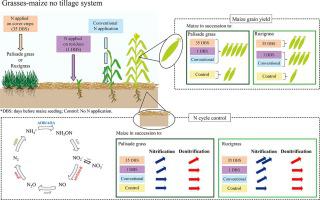Geoderma ( IF 6.1 ) Pub Date : 2021-09-01 , DOI: 10.1016/j.geoderma.2021.115423 Letusa Momesso 1, 2, 3 , Carlos Alexandre Costa Crusciol 3 , Heitor Cantarella 4 , Katiuça Sueko Tanaka 3 , George A. Kowalchuk 2 , Eiko Eurya Kuramae 1, 2

|
Residues of cover crop grasses release nitrogen (N) to subsequent crops, which can contribute to sustainable agricultural management and prevent increases in N-loss-related microorganisms. Moreover, applying N fertilizer to cover crops can enhance the N-use efficiency and yields of subsequent cash crops and tighten the N cycle in the soil. However, the long-term effects of N fertilization of cover crops on soil microbiota and the N cycle in tropical grass-crop no-till systems are unknown. The aim of this study was to evaluate the long-term effects of the timing of N fertilization of cover crops or maize on crop yields, total microbial abundances and N-cycle gene abundances at the time of maize harvest. We carried out a field experiment with two cover crops (palisade grass (Urochloa brizantha) and ruzigrass (U. ruziziensis) fertilized with 120 kg N ha−1 (ammonium sulfate) at one of three times: (i) broadcast over the green cover crops at 35 days before maize seeding (35 DBS), (ii) broadcast over the cover crop straw residues at 1 day before maize seeding (1 DBS), and (iii) as side-dressing at the maize V4 growth stage according to the conventional method (band-applied 0.05 m from the maize row). A control treatment without N application was also carried out for both cover crop species. Except for the control, 40 kg N ha−1 as ammonium sulfate was subsurface band-applied in all treatments 0.05–0.10 m from the maize row at maize seeding, corresponding to 160 kg N ha−1. The total bacterial, archaeal and fungal abundances and abundances of microbial genes encoding enzymes of the N cycle in the soil were quantified by real-time PCR at the maize harvest stage. Overall, maize yield increased significantly in all N fertilizer applications (average 13 Mg ha−1) compared with the control (6 Mg ha−1) over three growing seasons, with maize following palisade grass having the highest yield. The abundances of archaea and fungi in soil were highest under palisade grass that received N at 35 DBS, with values of 4.6 × 106 and 1.7 × 107 gene copies/g of dry soil, respectively. Both cover crop straw production and N release to the soil were positively correlated with the total microbe densities. When ruzigrass was the cover crop, low N enhanced nifH abundance. Archaeal amoA abundance was positively correlated with cover crop biomass and N release regardless of the N treatment and was highest under palisade grass. Bacterial amoA, nirK, and nirS abundances were highest in soil under ruzigrass and were not linked to cover crop biomass mineralization. We conclude that N fertilizer should be applied using the currently recommended method (40 and 120 kg N ha−1 at seeding and side-dressed in maize, respectively) following palisade grass to achieve high maize yield while controlling the level of N loss from tropical soil via nitrification and denitrification.
中文翻译:

优化覆盖作物和施肥时间以实现高玉米产量和氮循环控制
覆盖作物草的残留物向后续作物释放氮 (N),这有助于可持续农业管理并防止与氮损失相关的微生物增加。此外,在覆盖作物上施氮肥可以提高后续经济作物的氮素利用效率和产量,并加强土壤中的氮素循环。然而,覆盖作物施氮对土壤微生物群和热带草作物免耕系统中氮循环的长期影响尚不清楚。本研究的目的是评估覆盖作物或玉米施氮时间对玉米收获时作物产量、总微生物丰度和 N 循环基因丰度的长期影响。我们对两种覆盖作物(栅栏草 ( Urochloa brizantha ) 和 ruzigrass (U. ruziziensis ) 以 120 kg N ha -1(硫酸铵)施肥,以下列三种方式之一施肥:(i) 在玉米播种前 35 天在绿色覆盖作物上播种 (35 DBS),(ii) 在覆盖作物上播种玉米播种前 1 天的秸秆残留物 (1 DBS),和 (iii)根据常规方法(从玉米行 0.05 m 处施肥)作为玉米 V 4生长阶段的侧施。还对两种覆盖作物物种进行了不施氮的对照处理。除了对照,40 kg N ha -1作为硫酸铵在所有处理中在距玉米行距 0.05-0.10 m 的所有处理中进行带状施用,对应于 160 kg N ha -1. 在玉米收获阶段通过实时 PCR 对土壤中细菌、古细菌和真菌的总丰度和编码氮循环酶的微生物基因的丰度进行量化。总体而言,在三个生长季节中,与对照(6 Mg ha -1)相比,所有施氮肥(平均 13 Mg ha -1)的玉米产量均显着增加,其中栅栏草之后的玉米产量最高。土壤中古菌和真菌的丰度在接受N 35 DBS的栅栏草下最高,分别为4.6 × 10 6和1.7 × 10 7基因拷贝数/g 干土,分别。覆盖作物秸秆产量和向土壤中释放的氮均与总微生物密度呈正相关。当 ruzigrass 是覆盖作物时,低氮增加了nifH丰度。无论氮处理如何,古菌amoA丰度与覆盖作物生物量和氮释放呈正相关,并且在栅栏草下最高。ruzigrass下土壤中的细菌amoA、nirK和nirS丰度最高,并且与覆盖作物生物量矿化无关。我们得出结论,应使用当前推荐的方法(40 和 120 kg N ha -1 分别在玉米中播种和侧施)跟随栅栏草实现高玉米产量,同时通过硝化和反硝化控制热带土壤中的氮损失水平。



























 京公网安备 11010802027423号
京公网安备 11010802027423号